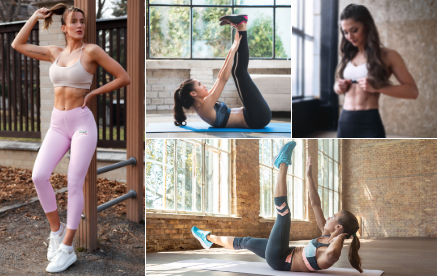Table of Contents
Many people consider the lower abdomen to be a problematic area. It often stores subcutaneous fat, which we would like to get rid of. That is usually not possible without changes in diet and training routine. It is important to include effective lower ab exercises, which will also help strengthen and firm up the entire core. This way you will get strong, well-developed abs that looks great and, at the same time, help maintain good posture.
In the article, you will find lower ab exercises for beginners and advanced. You can immediately forget about the endless sets of sit-ups. It is essential to engage the abdomen muscles comprehensively and not rely on just one exercise. In addition, we have prepared tips for advanced athletes for the best results possible.
Can lower ab exercises help you get rid of belly fat?
If your goal is to lose weight, you should not rely solely on exercises in this area. Unfortunately, they cannot delete, burn or sweat out excess fat. You need to look at it from a complex point of view. It is not possible to lose weight only on specific parts of the body.
When you lose weight, fat begins to disappear from the whole body. And where it starts to decrease faster is affected by genetics, hormones, and the overall lifestyle. You may lose weight first, especially in the thighs and buttocks, while lower abdomen later. But someone may experience the exact opposite. [1–2]
The caloric deficit then plays a key role, which you achieve by adjusting your diet, training and overall lifestyle. Don’t worry, you don’t have to use drastic diets or detoxes. You will lose weight permanently thanks to gradual small changes that will lead you to your goal. As a reward you will get nice abs and get fit. [1–2]
If you want to learn specific tips that can help you lose weight, you can find them in our article Lose Belly Fat and Get into Shape with Our Simple Guide.

13 Effective Lower Ab Exercises
As with other muscle groups, it is necessary to exercise regularly to achieve results. At the same time, however, it is not appropriate to overload this muscle group and exercise every day because this would not give the muscles room to recover. Beginners should include complex ab training 2–3 times a week, while advanced athletes up to 4 times. But it always depends on the athlete’s specific training plan and goals. [3–4]
If you are a beginner, you should choose the no equipment variations and focus on the correct technique. Once you are confident in their performance, you can increase the number of reps and sets or make the exercise more demanding with equipment. As a result, you will stick to the principle of progressive overload, which is crucial for muscle growth and strengthening.
Guide on ab training
- Work your abs 2–4 times a week, depending on your fitness level.
- Add it to another muscle group or create a HIIT or circuit training with our ab exercises.
- Choose 2–3 lower ab exercises and add them to a complex ab workout or work on your lower abs separately, including 4–5 exercises about 1–2 times a week.
- You will find the recommended number of reps in the description of each exercise.
- The ideal number of sets is 2–4.
- Don’t forget to warm up slightly before the workout (running on the spot or jumping rope).
- Prepare an exercise mat and sliders, which you can optionally replace with two towels.
- If you want to try more challenging variations, prepare a kettlebell, dumbbells, a plate, a balance pad, a slam ball or ankle and wrist weight wraps.
- Find some time for light stretching after the main part.
You might be interested in these products:
1. Single Leg Heel Taps
- Starting position: Lie on your back and place your arms alongside the body. Raise your legs and bend your knees 90 degrees. Brace your abs.
- Performance: Touch the mat with your one heel while exhaling and return it while inhaling. Repeat the same with the other leg. Keep the whole back on the mat throughout the exercise. Also, make sure that the movement comes mainly from the abs. Complete 12–20 reps.
- Common mistakes: A small range of motion, insufficient activation of abdominal muscles, bent lower back.
- How to make the exercise more difficult? You can increase the difficulty by straightening your legs slightly or placing a weight straps on your ankles.
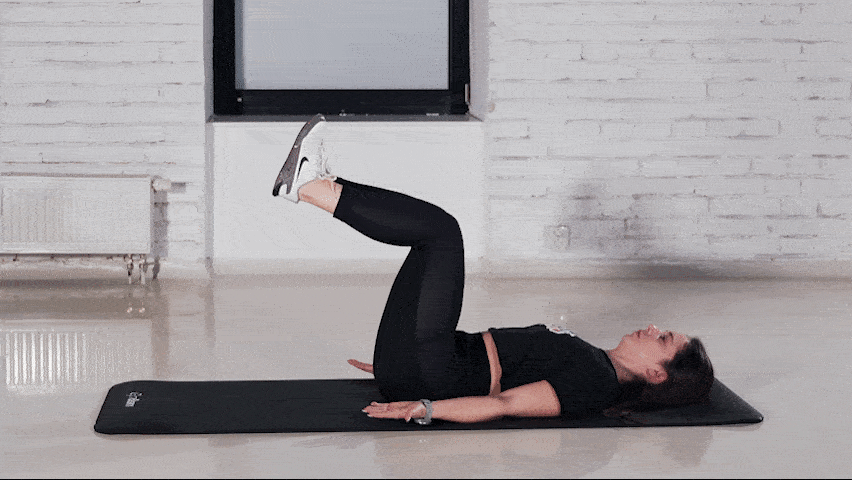
2. Mountain Climber
- Starting position: Kneel on the ground, do the higher plank. Place your open hands under your shoulders (wider than shoulder-width apart). Keep your shoulders back and down and your shoulder blades together. Brace your core and try to maintain your body in a line. Don’t bend your back, especially in the lumbar area.
- Performance: Bend one knee and pull it towards the elbow (the arms are stretched) while exhaling. Then return to the starting position and do the same to the other side. Continue until you complete 12–20 reps.
- Common mistakes: Bent back, the hips fall to the ground, excessive pelvis lift, a small range of motion.
- How to make the exercise more difficult? Put your hands on a balance pad, fit ball or slam ball. You can also attach a load to the ankles.
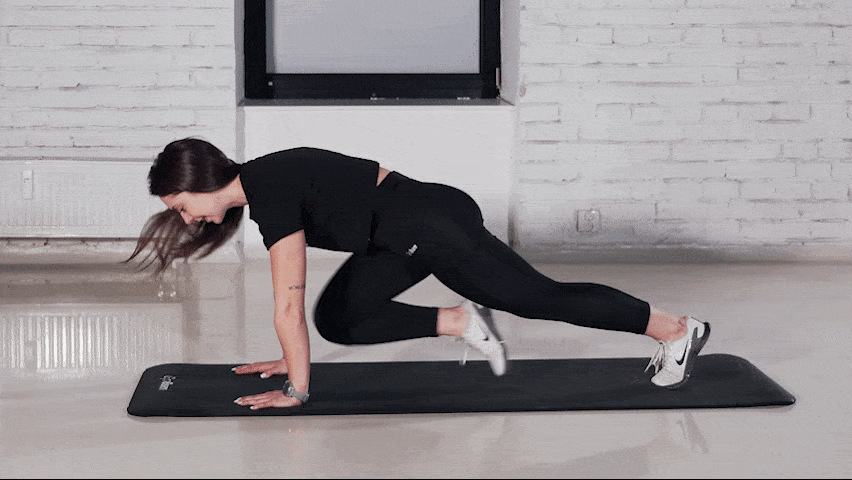
3. Cross-Body Mountain Climbers
- Starting position: Kneel on the ground, do the higher plank. Place your open hands under your shoulders (wider than shoulder-width apart). Keep your shoulders back and down and your shoulder blades together. Brace your core and try to maintain your body in a line. Don’t bend your back, especially in the lumbar area.
- Performance: Bend one knee and pull it towards the opposite elbow (extend your arms) while exhaling. Then return to the starting position and do the same to the other side. Continue until you complete 12–20 reps.
- Common mistakes: Bent back, the hips fall to the ground, excessive pelvis lift, a small range of motion.
- How to make the exercise more difficult? Lean your hands on a balance pad, platform, fit ball or slam ball. You can also attach ankle weight straps.

4. Scissors
- Starting position: Lie on your back. Bend your elbows, and place your palms on the back of the head (it is raised a few centimetres off the ground). Slightly lift the upper back and bend your knees. The elbows point out. If you tend to pull them together, put your hands crossed your chest.
- Performance: Engage your abs and start pulling one leg close to the chest and placing the other a few centimetres above the ground. This leg movement should resemble scissors. Don’t forget to breathe and focus on the motion. It should be coming mainly from the abs. Make sure you keep your lower back on the mat during the whole time. Complete 8–12 reps.
- Common mistakes: A small range of motion, insufficient activation of abdominal muscles, bent lower back.
- How to make the exercise more difficult? Increase the range of motion of the lower limbs or attach ankle wrist wraps.
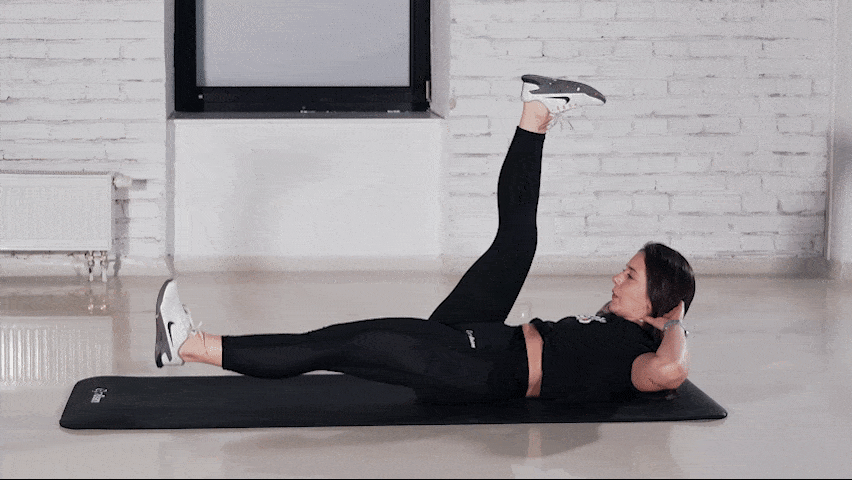
5. Slider Knee Tucks
- Starting position: Place sliders under your feet and do the upper plank. Place the open palms under your shoulders (wider than shoulder-width apart). Keep your shoulders back and down and your shoulder blades together. Brace your core and try to maintain your body in a line.
- Performance: Bend your elbows and pull them under the chest while exhaling. Then return to the starting position while inhaling and move on to the next rep. Complete 12–20 reps.
- Common mistakes: A small range of motion, insufficient activation of abdominal muscles, bent lower back.
- How to make the exercise more difficult? Lean your hands on a balance pad, platform, fit ball or slam ball. You can also attach ankle weight straps.

6. Slider Pike Up
- Starting position: Place sliders under your feet and do the upper plank. Place the open palms under your shoulders (wider than shoulder-width apart). Keep your shoulders back and down and your shoulder blades together. Brace your core and try to maintain your body in a line.
- Performance: Pull the feet towards the palms while exhaling (the knees stay slightly bent). Then return to the starting position while inhaling and move on to the next rep. Continue until you complete 8–12.
- Common mistakes: A small range of motion, insufficient activation of abdominal muscles, bent lower back.
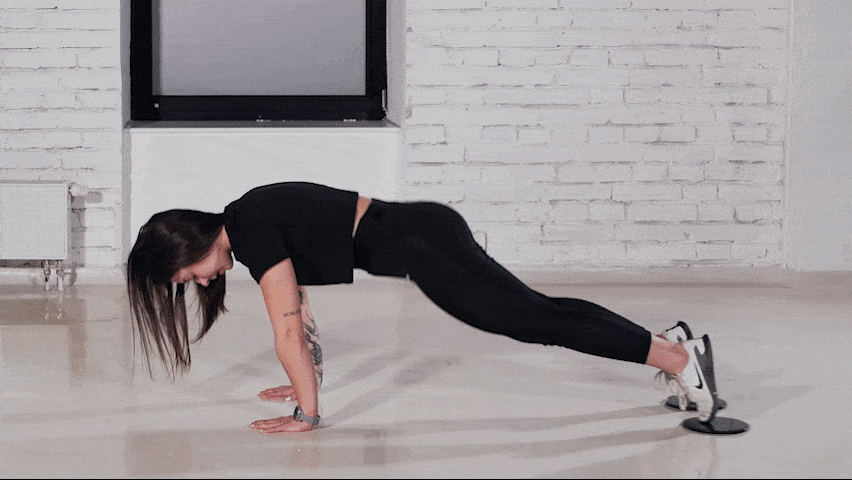
7. Lying Leg Raises
- Starting position: Lie on your back and place your arms alongside the body. Raise your head and upper back off the mat a little. Slightly bend your knees and lift them a few centimetres above the ground. Brace your core.
- Performance: Carefully pull your bent legs towards your head while exhaling. Remember to keep your whole back on the mat. Return to the starting position while inhaling and repeat the exercise. Continue until you complete 8–12 reps.
- Common mistakes: A small range of motion, insufficient activation of abdominal muscles, uncontrolled movement.
- How to make the exercise more difficult? Place a dumbbell between your ankles or attach weight straps to them.
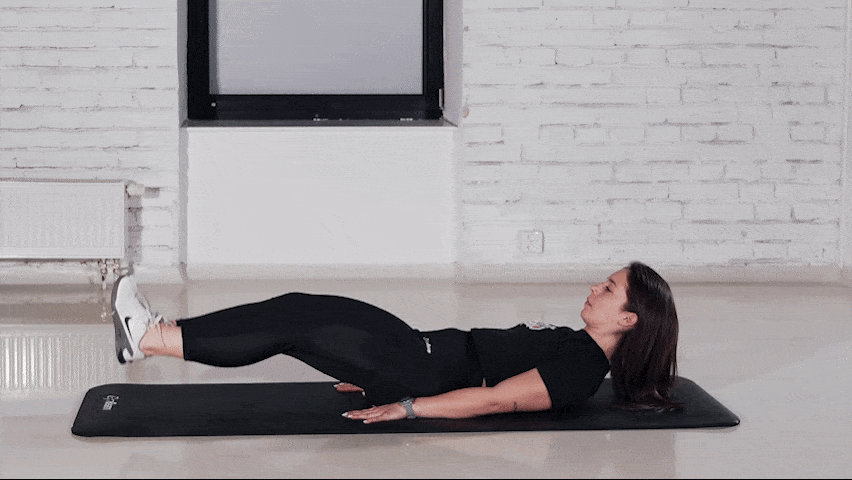
8. Alternating Side Plank
- Starting position: Lie on your side with your legs outstretched. Keep your feet on top of each other and do the lower plank. Brace your core.
- Performance: Raise the upper arm while exhaling and remain in this position for 1–2 seconds. Then change your arms and do the same to the other side. Continue until you complete 8–12 reps.
- Common mistakes: Bent back, the hips fall to the ground, uncontrolled movement.
- How to make the exercise more difficult? You can simultaneously lift the leg together with the arm or rest your hands on the balance pad.
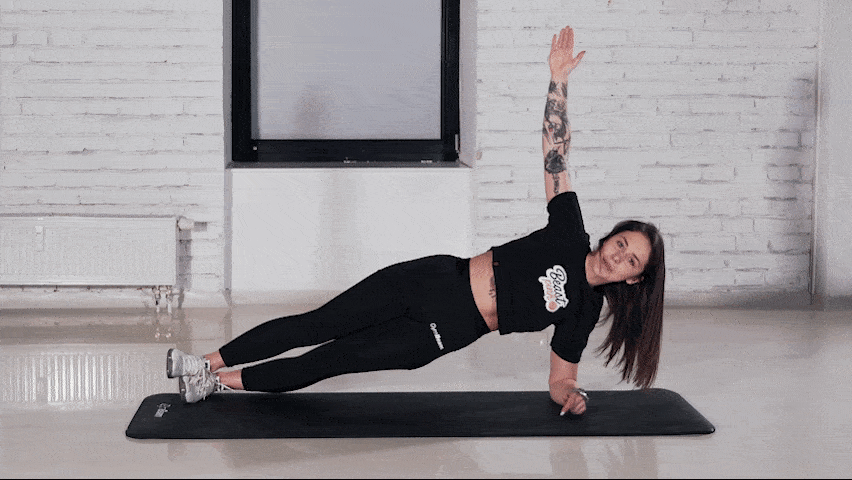
9. Roll-Ups
- Starting position: Lie on your back with outstretched legs and raise your arms.
- Performance: Raise your arms smoothly up to the sitting position without bending your legs by activating your abs while exhaling. Then carefully return to the starting position while inhaling and repeat the exercise. Complete 8–12 reps.
- Common mistakes: A small range of motion, uncontrolled movement.
- How to make the exercise more difficult? Grab the kettlebell, dumbbell or plate with both hands and lift it the same way.
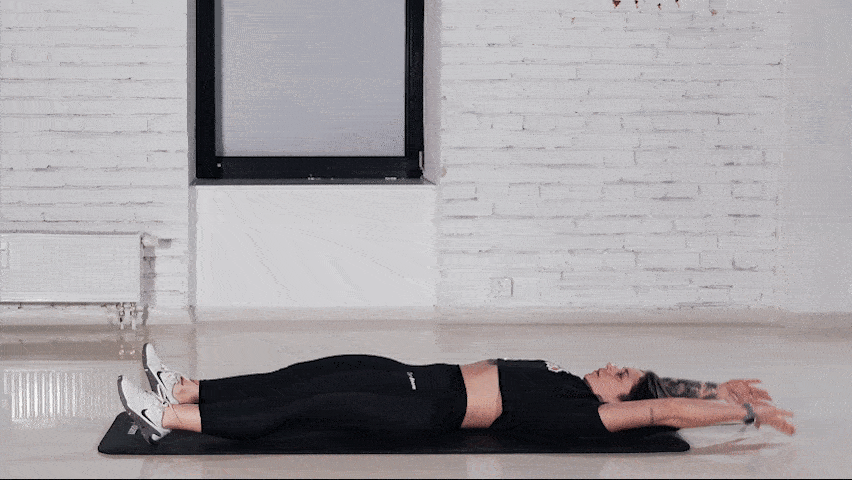
10. Crossbody Toe Touch Crunch
- Starting position: Lie on your back and raise your arms upwards. Lift your head and upper back a few centimetres off the ground. Brace your abs.
- Performance: Raise and pull your right arm and left leg to one another (they may touch above the body) while exhaling. Return to the starting position while inhaling and do the same on the other side. Make sure you keep your lower back on the mat all the time. Complete 8–12 reps.
- Common mistakes: A small range of motion, insufficient activation of abdominal muscles.
- How to make the exercise more difficult? Attach the weight to your wrists or ankles.
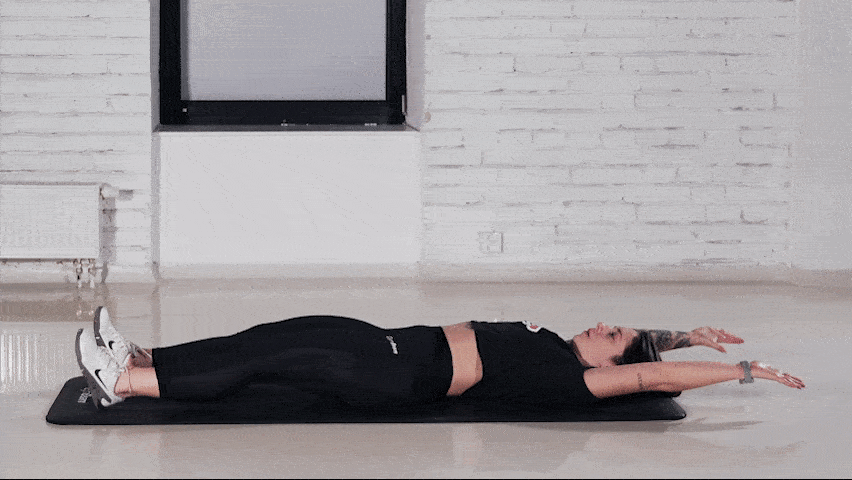
11. Raised Legs Crunch
- Starting position: Lie on your back, raise your legs towards the ceiling (you can slightly bend your knees) and raise your arms upwards.
- Performance: Raise your head and upper back off the mat and bring your hands to your feet while exhaling. Keep your lower back on the mat during the whole time. You don’t have to lift too much. Then return to the starting position while inhaling and repeat the exercise. Complete 8–12 reps.
- Common mistakes: A small range of motion, insufficient activation of abdominal muscles.
- How to make the exercise more difficult? Grab the kettlebell, dumbbell or plate with both hands and rise to your feet in the same way.
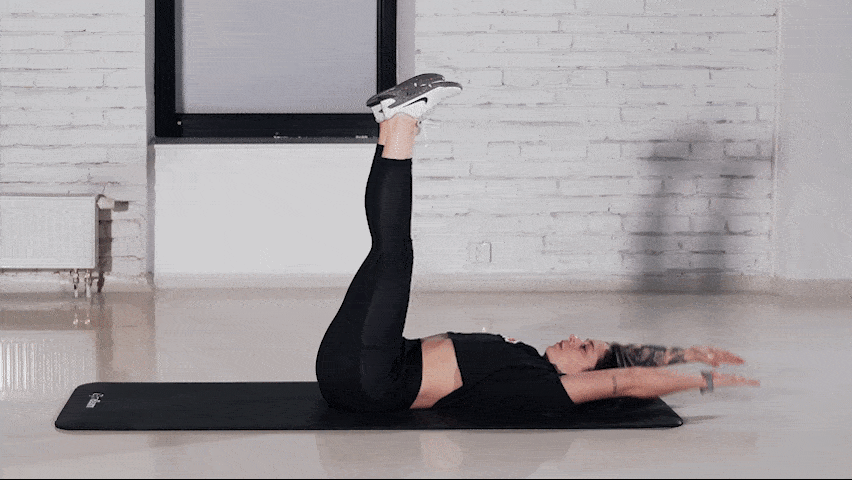
12. Plank Steps
- Starting position: Kneel on the ground, do the higher plank. Place your open hands under your shoulders (wider than shoulder-width apart). Keep your shoulders back and down and your shoulder blades together. Brace your core and try to maintain your body in a line. Don’t bend your back, especially in the lumbar area.
- Performance: Bend one leg and take one step to the side (under your body) while exhaling and do the same to the other side. Then return your legs to the starting position one by one and repeat the exercise. Continue until you complete 12–20 reps.
- Common mistakes: Bent back, the hips fall to the ground, raising the pelvis excessively.
- How to make the exercise more difficult? Lean your hands on a balance pad, platform or slam ball. You can also attach ankle wrist wraps.
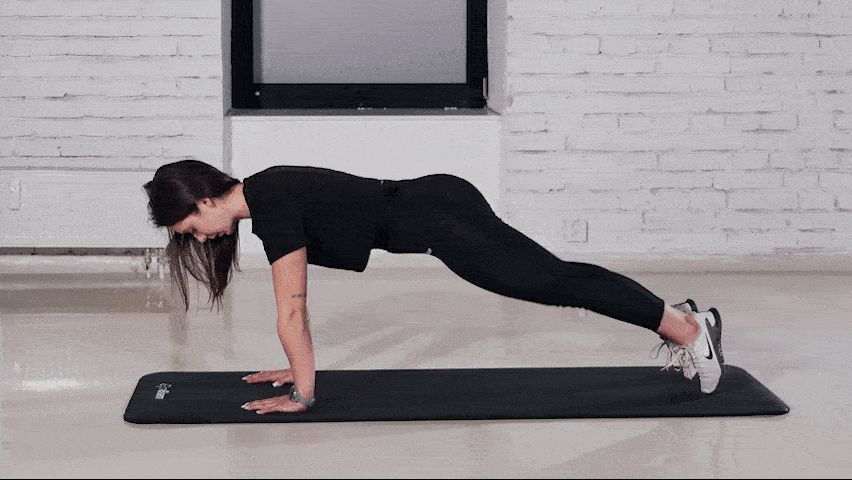
13. Slider Plank Jack
- Starting position: Kneel on the ground and place your feet on the sliders. Then do the lower plank. The elbows are under the shoulders (wider than shoulder-width apart). The open palms are facing each other. Keep your shoulder back and down and your shoulder blades together. Brace your core and try to maintain your body in a line. Don’t bend your back, especially in the lumbar area.
- Performance: Take a step to the side with one leg without taking it off the mat while exhaling. Then return it and do the with the other leg. Continue until you complete 8–12 reps.
- Common mistakes: Bent back, the hips fall to the ground, excessive lifting of the pelvis, uncontrolled movement.
- How to make the exercise more difficult? Open and close both legs simultaneously or place a resistance band on your ankles or knees and then continue in the same way.
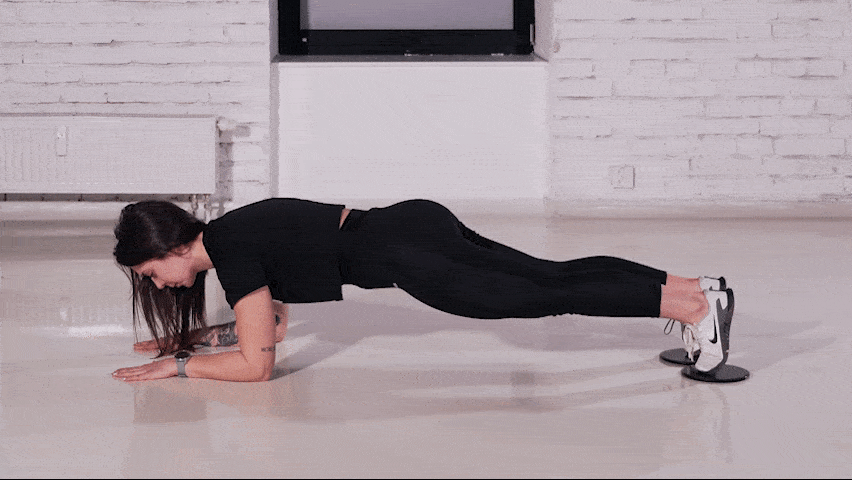
Are you looking for some other tips?
- If you are also looking for exercises for the hips, oblique abdominal muscles or core, you will find everything in our article 21 Best Bodyweight Exercises.
- You can also work your abs with a fit ball according to the article 10 Effective Core & Booty Exercises with Fit Ball.
- If you don’t have much time for exercise, try Effective 6-Minute Abs Workout at Home.
- If your goal is to lose weight, you should not miss our article Simple Weight Loss Basic: You’ll Be Surprised What’s Really Important.
What should you remember?
Thanks to today’s article, you already know which exercises are worth including in training if you want to focus on strengthening the lower abdomen. They are an awesome tool for developing and strengthening this problematic muscle group. You can add them to another muscle group or perform them separately at least twice a week. If you also adjust the diet and leave the muscles space for sufficient regeneration, the results will be even better. These are the essential principles for achieving your fitness goals.
Was this article helpful to you? If so, send it to your friends and show them inspiration for lower abs workout.
[1] PubMed. Fat loss depends on energy deficit only, independently of the method for weight loss. – https://pubmed.ncbi.nlm.nih.gov/18025815/
[2] Precision Nutrition. How To Lose Belly Fat, According to Science. – https://www.precisionnutrition.com/how-to-lose-belly-fat
[3] BarBend. How Often Should You Train Your Abs? – https://barbend.com/how-often-train-abs/
[4] T NATION. The Thinking Man’s Guide to Ab training. – https://www.t-nation.com/training/the-thinking-mans-guide-to-ab-training/

